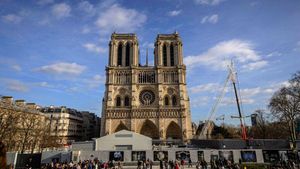Mount Taranaki, known by its indigenous name Taranaki Maunga, has achieved unprecedented legal status as the first mountain to be recognized as a person under New Zealand law. This landmark legislation, passed unanimously on January 30, signals not only significant progress for indigenous rights but also shifts New Zealand's relationship with its natural features. The volcano, which stands majestically at 8,261 feet, is now endowed with the legal rights and responsibilities of human beings.
Historically revered as an ancestor by the Māori people, Taranaki Maunga's recognition is rooted deep within New Zealand’s cultural heritage. According to BBC, the Māori view their relationship with the environment as one where humans, animals, and mountains are interconnected, supporting the argument for the mountain's newfound legal status. The Māori people have long considered the mountain sacred, leading to calls for recognition of its significance beyond mere geographical terms.
The impetus behind this groundbreaking change stems from centuries of struggle. The Māori endured land confiscations and injustices dating back to the colonization of New Zealand. The British explorer James Cook originally named it 'Mount Egmont,' and subsequent crown seizures violated the Treaty of Waitangi, which was meant to protect Māori rights. For decades, discussions were held between Māori leaders and the government to address these past wrongs.
The Taranaki Maunga Collective Redress Bill, which facilitated this historic change, was celebrated as necessary to correct these injustices and reassess the significance of the natural environment through the lens of Māori customs and beliefs. Paul Goldsmith, the New Zealand minister overseeing the bill's passage, stated, "We must acknowledge the hurt caused by past wrongs, so we can look to the future to support iwi to realize their own aspirations and opportunities," reflecting the government's commitment to reconciliation.
Taranaki Maunga's new legal identity means it will no longer be owned by the government but co-managed by both the iwi community and government representatives. This model aims to facilitate environmental conservation efforts, ensuring the mountain's health and well-being are sustained.
New Zealand previously granted similar legal personalities to significant natural landmarks, such as Te Urewera National Park and the Whanganui River. By bestowing personhood to these features, the nation has established itself as a leader in recognizing environmental rights alongside indigenous practices. Aisha Campbell, from the Taranaki iwi, emphasized the importance of this decision, stating, "The mountain, the river, the forest—they are all living ancestors to us. Their recognition as legal persons means we can finally protect them as they deserve."
The transformation of Mount Taranaki’s legal status also indicates how countries can dictate environmental policies and models of stewardship based on indigenous beliefs. Globally, nations like Ecuador, India, Colombia, and Bolivia have started to follow suit, acknowledging natural features as legal entities deserving protection.
This move toward personhood for Taranaki Maunga includes not just legal rights but encompasses responsibilities as well, creating obligations for its guardians to maintain its ecological health. Damage done to the mountain can now be legally contested, changing the dynamics of environmental conservation and the legal framework around nature management.
Debbie Ngarewa-Packer, co-leader of the Māori Party and descendant of the Taranaki iwi, articulated the emotional weight of this decision saying, "Today, Taranaki, our maunga, our maunga tupuna, is released from the shackles, the shackles of injustice, of ignorance, of hate." This sentiment encapsulates the hope and optimism felt by many who see the recognition as not just symbolic but as concrete steps toward rectifying historical injustices.
While there continues to be public access to Taranaki Maunga for activities like hiking and snow sports, the focus will shift toward Māori stewardship and greater conservation efforts. The governance committee managing Taranaki Maunga will consist of four Māori representatives alongside four government-nominated members, ensuring shared responsibility and accountability.
The path to recognizing Taranaki Maunga as a legal person has been paved with challenges and triumphs alike. It serves as not only a victory for the Māori but as a precedent for future interactions between indigenous peoples and government entities. The case of Mount Taranaki is likely to inspire similar movements worldwide, urging nations to contend with their past and make amends through innovative and culturally respectful practices toward their natural environments.
By acknowledging Taranaki Maunga's legal personhood, New Zealand not only fortifies its commitment to indigenous rights but also redefines how society views its relationship with nature—a significant step forward for conservation and heritage. The recognition of Taranaki Maunga will undoubtedly resonate for generations, reinforcing the cultural, ecological, and legal importance of respecting the integral connections between all forms of life.



